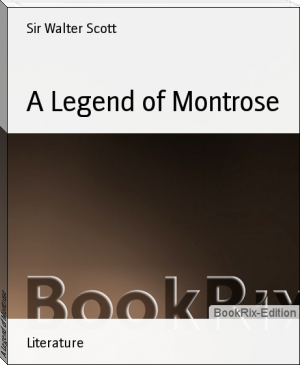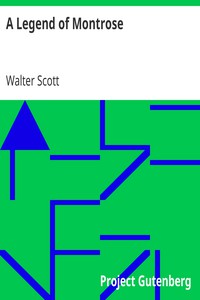Rob Roy — Complete, Walter Scott [top fiction books of all time txt] 📗

- Author: Walter Scott
Book online «Rob Roy — Complete, Walter Scott [top fiction books of all time txt] 📗». Author Walter Scott
The sept of MacGregor claimed a descent from Gregor, or Gregorius, third son, it is said, of Alpin King of Scots, who flourished about 787. Hence their original patronymic is MacAlpine, and they are usually termed the Clan Alpine. An individual tribe of them retains the same name. They are accounted one of the most ancient clans in the Highlands, and it is certain they were a people of original Celtic descent, and occupied at one period very extensive possessions in Perthshire and Argyleshire, which they imprudently continued to hold by the coir a glaive, that is, the right of the sword. Their neighbours, the Earls of Argyle and Breadalbane, in the meanwhile, managed to leave the lands occupied by the MacGregors engrossed in those charters which they easily obtained from the Crown; and thus constituted a legal right in their own favour, without much regard to its justice. As opportunity occurred of annoying or extirpating their neighbours, they gradually extended their own domains, by usurping, under the pretext of such royal grants, those of their more uncivilised neighbours. A Sir Duncan Campbell of Lochow, known in the Highlands by the name of Donacha Dhu nan Churraichd, that is, Black Duncan with the Cowl, it being his pleasure to wear such a head-gear, is said to have been peculiarly successful in those acts of spoliation upon the clan MacGregor.
The devoted sept, ever finding themselves iniquitously driven from their possessions, defended themselves by force, and occasionally gained advantages, which they used cruelly enough. This conduct, though natural, considering the country and time, was studiously represented at the capital as arising from an untameable and innate ferocity, which nothing, it was said, could remedy, save cutting off the tribe of MacGregor root and branch.
In an act of Privy Council at Stirling, 22d September 1563, in the reign of Queen Mary, commission is granted to the most powerful nobles, and chiefs of the clans, to pursue the clan Gregor with fire and sword. A similar warrant in 1563, not only grants the like powers to Sir John Campbell of Glenorchy, the descendant of Duncan with the Cowl, but discharges the lieges to receive or assist any of the clan Gregor, or afford them, under any colour whatever, meat, drink, or clothes.
An atrocity which the clan Gregor committed in 1589, by the murder of John Drummond of Drummond-ernoch, a forester of the royal forest of Glenartney, is elsewhere given, with all its horrid circumstances. The clan swore upon the severed head of the murdered man, that they would make common cause in avowing the deed. This led to an act of the Privy Council, directing another crusade against the “wicked clan Gregor, so long continuing in blood, slaughter, theft, and robbery,” in which letters of fire and sword are denounced against them for the space of three years. The reader will find this particular fact illustrated in the Introduction to the Legend of Montrose in the present edition of these Novels.
Other occasions frequently occurred, in which the MacGregors testified contempt for the laws, from which they had often experienced severity, but never protection. Though they were gradually deprived of their possessions, and of all ordinary means of procuring subsistence, they could not, nevertheless, be supposed likely to starve for famine, while they had the means of taking from strangers what they considered as rightfully their own. Hence they became versed in predatory forays, and accustomed to bloodshed. Their passions were eager, and, with a little management on the part of some of their most powerful neighbours, they could easily be hounded out, to use an expressive Scottish phrase, to commit violence, of which the wily instigators took the advantage, and left the ignorant MacGregors an undivided portion of blame and punishment. This policy of pushing on the fierce clans of the Highlands and Borders to break the peace of the country, is accounted by the historian one of the most dangerous practices of his own period, in which the MacGregors were considered as ready agents.
Notwithstanding these severe denunciations,—-which were acted upon in the same spirit in which they were conceived, some of the clan still possessed property, and the chief of the name in 1592 is designed Allaster MacGregor of Glenstrae. He is said to have been a brave and active man; but, from the tenor of his confession at his death, appears to have been engaged in many and desperate feuds, one of which finally proved fatal to himself and many of his followers. This was the celebrated conflict at Glenfruin, near the southwestern extremity of Loch Lomond, in the vicinity of which the MacGregors continued to exercise much authority by the coir a glaive, or right of the strongest, which we have already mentioned.
There had been a long and bloody feud betwixt the MacGregors and the Laird of Luss, head of the family of Colquhoun, a powerful race on the lower part of Loch Lomond. The MacGregors' tradition affirms that the quarrel began on a very trifling subject. Two of the MacGregors being benighted, asked shelter in a house belonging to a dependant of the Colquhouns, and were refused. They then retreated to an out-house, took a wedder from the fold, killed it, and supped off the carcass, for which (it is said) they offered payment to the proprietor. The Laird of Luss seized on the offenders, and, by the summary process which feudal barons had at their command, had them both condemned and executed. The MacGregors verify this account of the feud by appealing to a proverb current amongst them, execrating the hour (Mult dhu an Carbail ghil) that the black wedder with the white tail was ever lambed. To avenge this quarrel, the Laird of MacGregor assembled his clan, to the number of three or four hundred men, and marched towards Luss from the banks of Loch Long, by a pass called Raid na Gael, or the Highlandman's Pass.
Sir Humphrey Colquhoun received early notice of this incursion, and collected a strong force, more than twice the number of that of the invaders. He had with him the gentlemen of the name of Buchanan, with the Grahams, and other gentry of the Lennox, and a party of the citizens of Dumbarton, under command of Tobias Smollett, a magistrate, or bailie, of that town, and ancestor of the celebrated author.
The parties met in the valley of Glenfruin, which signifies the Glen of Sorrow—-a name that seemed to anticipate the event of the day, which, fatal to the conquered party, was at least equally so to the victors, the “babe unborn” of Clan Alpine having reason to repent it. The MacGregors, somewhat discouraged by the appearance of a force much superior to their own, were cheered on to the attack by a Seer, or second-sighted person, who professed that he saw the shrouds of the dead wrapt around their principal opponents. The clan charged with great fury on the front of the enemy, while John MacGregor, with a strong party, made an unexpected attack on the flank. A great part of the Colquhouns' force consisted in cavalry, which could not act in the boggy ground. They were said to have disputed the field manfully, but were at length completely routed, and a merciless slaughter was exercised on the fugitives, of whom betwixt two and three hundred fell on the field and in the pursuit. If the MacGregors lost, as is averred, only two men slain in the action, they had slight provocation for an indiscriminate massacre. It is said that their fury extended itself to a party of students for clerical orders, who had imprudently come to see the battle. Some doubt is thrown on this fact, from the indictment against the chief of the clan Gregor being silent on the subject, as is the historian Johnston, and a Professor Ross, who wrote





Comments (0)